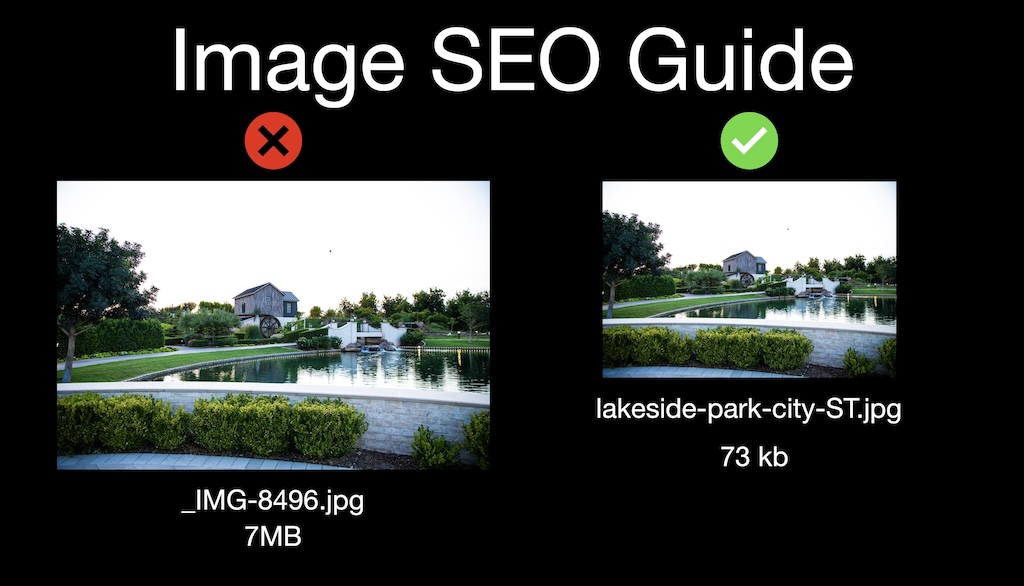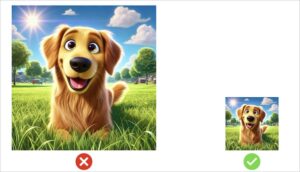
Image SEO Guide

Image DOs and DON'Ts
While many individuals concentrate on keywords, content and backlinks for Search Engine Optimization (SEO) the significance of image optimization is often underestimated. The size of your images plays a role in your websites SEO performance affecting aspects such as page loading speed, user experience and ultimately influencing your search engine rankings. In this article we will discuss the importance of image size in SEO strategies for optimizing images to boost your SEO efforts and practical steps you can take to achieve results.
Members of our SEO Autopilot plan benefit from all that is in this guide without having to do anything, as Image Optimization is just one of the included services in this ongoing plan.
This Image SEO guide covers:
- Image Size
- Image ALT text
- Image File Names
Why Image Size is Important for SEO
 Page Loading Speed; Oversized images can hinder your websites performance by slowing down its loading speed resulting in an user experience. Search engines like Google prioritize websites that load quickly; therefore if large images cause delays in page loading times it could have an impact on your search engine rankings.
Page Loading Speed; Oversized images can hinder your websites performance by slowing down its loading speed resulting in an user experience. Search engines like Google prioritize websites that load quickly; therefore if large images cause delays in page loading times it could have an impact on your search engine rankings.
Mobile Compatibility; With an increasing number of users accessing websites via devices it is essential that images are optimized for screens. If images are too large to load on devices users may encounter difficulties navigating the site leading to frustration and potentially increasing bounce rates. A factor that search engines consider.
Bandwidth Consumption; Large image files consume more bandwidth which can be problematic for users, with data plans.
Increasing the costs of your website can happen, especially when dealing with levels of website traffic. Search engines go through websites by crawling and indexing them considering factors. Images that are large, in size may slow down the crawling process potentially affecting the indexing efficiency of your content. To enhance your website’s SEO through image optimization focus on areas such as image size, Alt text and image names.
How To Improve Image Size
 Selecting the Right Format; Opt for JPEG for photos and PNG for graphics featuring backgrounds. Avoid BMP or TIFF files due to their sizes.
Selecting the Right Format; Opt for JPEG for photos and PNG for graphics featuring backgrounds. Avoid BMP or TIFF files due to their sizes.- Resizing Your Images; Prior, to uploading an image adjust its dimensions accordingly. It’s unnecessary to upload a 4000×3000 image when you only need it to be 800×600 pixels.
- Compressing Your Images; Post resizing compress the image to further decrease its file size without compromising quality.
You have the option to utilize tools such, as ImageResizer.com for this task. Simply upload your image select the level of compression and then download the optimized file. - Check Your Page Speed; Once you’ve optimized your images assess your websites loading speed using tools like Google PageSpeed Insights. If the page still loads slowly consider compression.
How To Utilize Alt Text for Images
 Text (or ALT text) is utilized to describe an images content. This is crucial, for SEO since search engines cannot visually interpret images but can read text. Here’s how to maximize its effectiveness:
Text (or ALT text) is utilized to describe an images content. This is crucial, for SEO since search engines cannot visually interpret images but can read text. Here’s how to maximize its effectiveness:
- Describe the Image; Ensure your Alt text accurately portrays whats depicted in the image. For instance if theres a photo of a retriever your Alt text could be ” retriever playing in the park.”
- Incorporate Keywords; When suitable include keywords in the text. However refrain from keyword usage—maintain a concise description.
- Keep It Brief; Aim for 125 characters or fewer. This guarantees that your Alt text is succinct and easily comprehensible.
Properly Naming Your Images
 The titles you assign to your images can impact SEO well.
The titles you assign to your images can impact SEO well.
Search engines take into account the file name when determining the ranking of images, in search results.
- Tip 1; Opt for Descriptive Names; rather than naming your file as “IMG_1234.jpg,” opt for a name such as “golden retriever park.jpg.”
- Tip 2; Use Hyphens, Not Underscores; When naming files use hyphens to separate words (“golden-retriever.jpg”). Search engines recognize hyphens as spaces but not underscores.
- Tip 3; Avoid Special Characters; Stick to letters, numbers and hyphens in file names. Special characters like %, $ & and others can lead to problems with how images are cataloged.
Additional Suggestions for Image SEO
We're Here to Help
We’ve been helping businesses show up more on Google for years. We’d be happy to review your site and share our findings with you during a brief 15-minute phone call. Schedule your free consultation today.